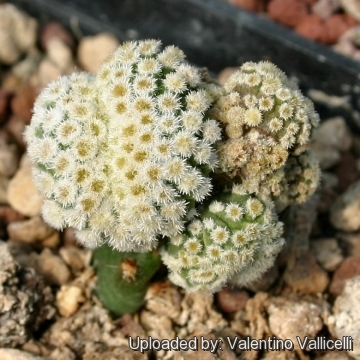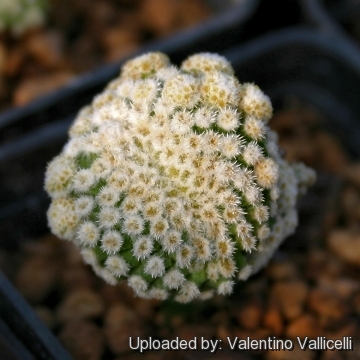
Strombocactus disciformis cv. Cactus Art Photo by: Valentino Vallicelli
Origin and Habitat: Garden origin (Nursery produced cultivar)
This cultivar has been originated in Cactus Art Nursery, the mutation came out spontaneously among hundred of typical plant in the spring of 2004.
Synonyms:
See all synonyms of Strombocactus disciformis
Description: Strombocactus disciformisSN|2103]]SN|2103]] cv. Cactus Art is an odd monstrous plant with narrow felt-like areoles derived from the well known Strombocactus disciformisSN|2103]]SN|2103]].
Habit: This cultivars is easily grown into crowded clumps or mounds, and tends to offset more abundantly than the normal form. Most plants will crest readily, and clumps can be produced in a few years.
Stem: Depressed-globose to somewhat elongated (depending on growing condition) 2-5 cm in diameter, blue-green with greyish tinge, with white wool in the centre, and also in the older areoles.
tubercles: Rhomboid and imbricate, somewhat laterally compressed, and often thinner than the above standing areoles.
Areoles: Very distinctive, creamy-white, woolly, conspicuous, in relief, 2-4 mm broad.
Spines: Extremely, short bristle-like that give the areoles a characteristic felty appearance, in fact these areoles are firm to the touch because they are densely covered by innumerable tiny spines. The younger areoles at the stems apex are greenish.
Flowers. Not seen.
Remarks: A similar abnormal uncoordinated form of vegetative growth, is also seen in several cactus species.
Subspecies, varieties, forms and cultivars of plants belonging to the Strombocactus disciformis group
 Strombocactus disciformis (DC.) Britton & Rose: the stem is flattened or spherical, blue-green with greyish tinge 3 to 8 cm high and 3 to 9 cm across. It is composed of hard, spirally arranged rhomboid tubercles that are flattened and almost truncated above.
Strombocactus disciformis (DC.) Britton & Rose: the stem is flattened or spherical, blue-green with greyish tinge 3 to 8 cm high and 3 to 9 cm across. It is composed of hard, spirally arranged rhomboid tubercles that are flattened and almost truncated above. Strombocactus disciformis f. cristatus hort.: Crested form.
Strombocactus disciformis f. cristatus hort.: Crested form. Strombocactus disciformis subs. esperanzae Glass & S.Arias: (= S. pulcherrimus) is very similar to S. disciformis the only noticeable difference is the colour of the flowers that are bright magenta.
Strombocactus disciformis subs. esperanzae Glass & S.Arias: (= S. pulcherrimus) is very similar to S. disciformis the only noticeable difference is the colour of the flowers that are bright magenta. Strombocactus disciformis subs. jarmilae (Halda) Halda: like S. disciformis but with a smaller body, small flowers, long thin spines and some other minor differences. Distribution: Northern Mexico (Querétaro and Nuevo León)
Strombocactus disciformis subs. jarmilae (Halda) Halda: like S. disciformis but with a smaller body, small flowers, long thin spines and some other minor differences. Distribution: Northern Mexico (Querétaro and Nuevo León) Strombocactus disciformis f. polytomicous hort.: Polytomy is a form of cristation, an apex divided in a lot of smaller apexes. It is very unusual to see such a Strombocactus.
Strombocactus disciformis f. polytomicous hort.: Polytomy is a form of cristation, an apex divided in a lot of smaller apexes. It is very unusual to see such a Strombocactus. Strombocactus disciformis cv. Cactus Art: odd monstrous plant forming crowded clumps or mounds, and most plants will crest readily. Areoles felt-like in relief 2-4 mm broad, greenish at the stems apex when young. Spines mumerous very short bristle-like.
Strombocactus disciformis cv. Cactus Art: odd monstrous plant forming crowded clumps or mounds, and most plants will crest readily. Areoles felt-like in relief 2-4 mm broad, greenish at the stems apex when young. Spines mumerous very short bristle-like. Strombocactus disciformis cv. Cespitosa: This is a strange plant that forms lots of axillary shoots in a continuous series on almost each node starting from the base of the stem, while the typical Strombocactus disciformis is usually solitary.
Strombocactus disciformis cv. Cespitosa: This is a strange plant that forms lots of axillary shoots in a continuous series on almost each node starting from the base of the stem, while the typical Strombocactus disciformis is usually solitary.
 Strombocactus disciformis cv. Cactus Art Photo by: Valentino Vallicelli
Strombocactus disciformis cv. Cactus Art Photo by: Valentino Vallicelli Strombocactus disciformis cv. Cactus Art Photo by: Valentino Vallicelli
Strombocactus disciformis cv. Cactus Art Photo by: Valentino VallicelliCultivation and Propagation: Although regarded as a choice and difficult plant is not too difficult in a greenhouse, although grows quite slowly.
Soil: Use mineral well permeable mineral soil with little organic matter (peat, humus).
Exposure: They need a good amount of light shade to full sun this help to keep the plants healthy, although slow growth.
Watering: Water sparingly from March till October (weekly during summertime, if the weather is sunny enough) , with a little fertilizer added. Less or no water during cold winter months, or when night temperatures remain below 10° to prevent root loss. It is sensitive to overwatering (rot prone).
Hardiness: Keep perfectly dry in winter at temperatures from 5 to 15 degrees centigrade. (but it is relatively cold resistant and hardy to -5° C for short periods) In the rest period no high atmospheric humidity!! (Temperature Zone: USDA 9-11)
Propagation: Grafting since cutting root hardly. Plants are usually grafted onto column-shaped cacti but proved to be able to produce their own roots if degrafted.












